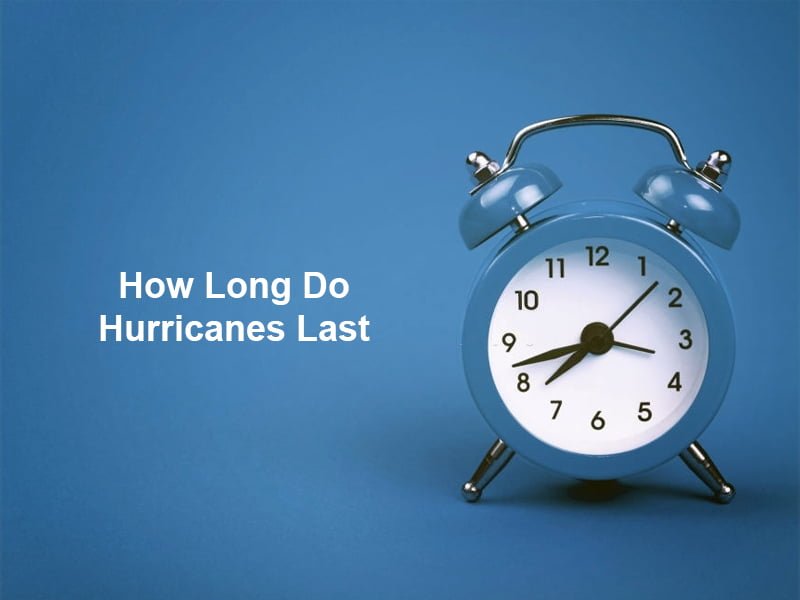Exact answer : 1 day to 31 days
Hurricanes are tropical cyclones that form near the equator over warm ocean water. Hurricanes are formed at about 80°F in warm ocean water. When the warm moist air above the ocean rises, it is replaced by cooler air. The cooler air will warm and start to rise. Storm clouds are formed and once the storm starts spinning and reaches 74 mph or higher the storm has officially become a Hurricane. It brings heavy rains and fast-blowing winds. Once the hurricane hits the land it runs out of warm moist air and weakens. The storm causes huge damage to the communities near the coast.
The scientific name of a Hurricane is a tropical cyclone. Tropical Cyclone has different names for different places. A tropical cyclone that forms in the Atlantic ocean is known as a hurricane. The cyclone that forms in the northern, eastern, and central Pacific is also known as a hurricane. The western Pacific cyclone is known as a typhoon and in the Indian Ocean, it is known as a cyclone. Each year 10 tropical storms form over the Atlantic ocean, Caribbean Sea, and the Gulf of Mexico. Atlantic hurricane season can be seen from June 1st to 30th November and Eastern Pacific hurricane season from May 15th to 30th November.

How Long Do Hurricanes Last?
Hurricanes can last for a day or long as a month. Typhoon John, in the northeast and northwest Pacific ocean in the year 1994, lasted for 31 days recorded as the longest-lasting tropical cyclone. Typhoon Loke in the year 2006, lasted for 8 consecutive days in the northeast and northwest Pacific ocean. Atlantic hurricane, Ginger lasted for 28 days in 1971. Hurricane last depends on whether it’s or not hits land. This huge storm forms because of the warm ocean water and grows stronger. Once the storm leaves the ocean it runs out of its source and becomes weaker as soon as it reaches land. It keeps on getting weaker until it dies out.
The most important aspect of hurricanes includes eye, eyewall and rain bands. The winds of the hurricane are very light in the center of the storm known as the eye. It has light winds and clear weather. The eyewall where the wind and the rains are the strongest and the rain bands spin-out from the center and give the storm a size. The naming rights for hurricanes are given to the World Meteorological Organisation. There are 6 different names for the Atlantic and Pacific storms, which are alternated every 6 years.
To know the intensity of a hurricane, meteorologists use the Saffir-Simpson hurricane wind scale to classify the hurricanes from category 1 to category 5. This scale can’t measure deadly hazards such as rainfall, storm surge, flooding, and tornadoes. The Saffir-Simpson hurricane wind estimates the possible property damage. A category 1 sustained wind reaches 74 to 95 mph (119-153 km/h) while category 2 sustained wind reaches 96-110 mph (154-177 km/h) both cause huge devastating winds and extensive damage. Hurricanes that reach above category 3 are known as major hurricanes. A category 5 hurricane speed reaches 157 mph or higher (252 km/h or higher). Major hurricanes cause severe damage to residents, power outages, and loss of life.
| Characteristics | Time | Tropical cyclone |
| Long-lasting tropical cyclone | 31 days | Typhoon John |
| Most intense sustained winds | 10 minutes | Cyclone Winston |
| Long-lasting category 5 winds | 5.50 consecutive days | Typhoon Nancy |
Why Does It Take That Long?
Several factors that contribute to the longevity of hurricanes depend upon warm ocean water, wind speed, and a moist atmosphere. The hurricanes are lasting longer after they make landfall and spreading their damage further inland. Research shows that warm ocean temperatures are the driving forces behind the long-lasting of hurricanes. If man-made climate change continues then the devastating power of hurricanes will rise thrice of it. The major impact will fall on the communities near the coast that they can’t handle.
Warm oceans water holds more moisture than cooler air. If hurricanes are the machine, warm ocean water beneath is it the power. When ocean water is warm as in the Atlantic ocean, it can supercharge hurricanes. As the hurricane moves over land it suddenly breaks its power. The hurricane becomes weak and breaks apart. But if a hurricane carries extra moisture it will act as battery backup.
Global warming is leading to hyperactive Atlantic storms. For case hurricane, Paulette was a category 2 long-lived hurricane that make landfall in Bermuda. The Paulette wave was formed on September 7 and it fluctuated in the next few days. It becomes weak and breaks. On September 14, the Paulette made a return and turn towards northeast Bermuda. The cyclone build-up and moved away from the land, reaching its peak with 1 minute sustained winds of 105 mph. On September 15, it becomes weak and breaks up.
Staying safe during storms can be done through a plan. People leaving near the hurricane-prone area would do well to protect their property in advance. Because hurricane causes huge damage when trees fall on the home. Pets should be leashed or put in a carrier and also to finding someone who will take care of them. Power generators are also an important tool if the power is cut for a long period of time, it needs to be taken out because they produce dangerous levels of carbon monoxide. During the evacuation zone, stay indoors because small things will blow around. Leave mobile homes and move to a shelter.
Conclusion
High wind causes hurricanes and its major impact falls on the environment as well as human life. After the hurricane, stops stay indoors until it’s safe to come out. Check for trapped people, without putting yourself in danger. Stay away from stale water as it may be electrically charged from underground power lines. Do not attempt to drive in flooding water.